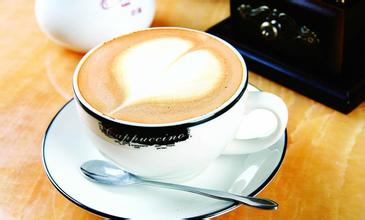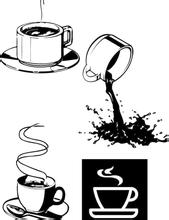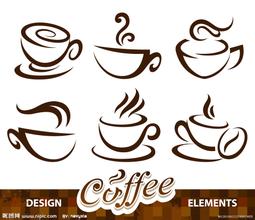On the Fusion and injection of Coffee
1. Cup height: refers to the distance between the milk jar and the coffee cup
The distance between the normal milk jar and the coffee cup is about 5ml 10cm (reference), which should be the distance between the mouth of the bottle and the coffee liquid level. Each person is different on this point, there is no exactly the same height and distance, there is no fixed height, but the purpose is only one point, that is, to fully integrate milk foam and coffee, because the density of milk foam is small and light, we often choose to increase the distance between the milk tank and the coffee liquid surface to avoid destroying the cleanliness and color of the oil. So we have to understand that the thicker the bubble, the higher the distance (impact), on the contrary, the thinner the bubble, the lower the distance.
two。 Milk flow size: refers to the thickness of the milk flow when the milk in the milk jar is poured into the coffee cup
The normal reference value is that the milk flow is a little thinner under constant conditions. The purpose of the milk flow size is to ensure that the cleanness and color of the oil will not be destroyed while fully merging the milk foam and coffee. The coarse milk flow will have a greater impact and will have a certain chance of breaking into the bottom of the cup to produce turbulence. Therefore, we will generally choose a finer milk flow to carry on the fusion. If we are more flexible, the size of the milk flow should match the quality of the milk foam. For example, if the milk foam is thicker, we need higher distance and finer milk flow, on the contrary, we can choose micro-coarse milk flow and closer milk flow to merge.
3. Fusion techniques: fusion techniques are roughly divided into three types: one-word fusion method, circle fusion method, fixed-point fusion method.
These techniques do not have a great impact on the fluidity of flower drawing: let's start with the differences between the three methods.
The one-word fusion method is the de-fusion of swinging left and right on a line, which greatly reduces the area of damaged oil and achieves the purpose of fusion.
The circle fusion method is the circle de-fusion method, which moves on the grease surface to a large extent to achieve the purpose of fusion.
The fixed-point fusion rule is to carry out fusion at a point, which hardly destroys the surface cleanliness of grease and achieves the purpose of fusion.
The three fusion methods have their own advantages and disadvantages, and the circle fusion method (that is, large area de-fusion) is the best in terms of fusion state and uniformity. The reason is very simple, the larger the fusion area, the easier it is to fully integrate milk foam and coffee. Fixed-point fusion and one-word fusion requires super grease and very good milk foam. Therefore, it is recommended to circle a large area to merge.
4. Fusion quantity: refers to how many milk bubbles are fused into the cup, and the amount of fusion liquid mainly affects the fluidity of the liquid surface during flower drawing (the following example assumes that the grease, milk foam and fusion techniques are consistent).
The process of fusion is actually the process of pouring milk into Espresso:
The amount of fusion liquid = the number of milk bubbles poured in = the fluidity strength of the liquid surface.
Less fusion liquid (that is, less milk bubbles poured in), less bubbles on the liquid surface and less resistance, so the fluidity is high.
If there is more fusion liquid (that is, more milk bubbles are poured into it), the more bubbles on the liquid surface, the greater the resistance, so the fluidity is low.
Therefore, the amount of the fusion liquid is different, and the fluidity of the liquid surface is also different.
In the style of flower drawing, there are also several schools. Let's compare the fusion weight of Japanese and Korean patterns:
The main feature of Japanese style pattern is that it covers a large area, and it is conceivable that a liquid surface with high mobility is needed for a large range of patterns, so the fusion weight of Japanese patterns is usually relatively small.
The main feature of the Korean style is that the pattern is neat and symmetrical, and the pattern with high symmetry needs a liquid surface with low mobility. So there are usually a lot of Korean pattern fusion.
So when we pull flowers, we choose the right amount of fusion according to the effect we want (mobility). One of my favorite words about fusion is to think of fusion as building and laying foundations. The more the fusion, the more stable the foundation. The less the fusion, the stronger the mobility of the foundation.
The above are several details of the fusion. After the fusion, it is time to draw flowers. Let's talk about the details of injection molding.
Injection molding:
1. Blooming point: refers to the point from which the liquid surface is used to shake the flower, and the flowering point determines the final position of the pattern in the cup. The flowering point of the heart-shaped flower is usually in the middle of the distance between the center of the liquid surface and the cup wall.
two。 The distance between the milk tank and the liquid surface: after finding the right blooming point, the next step is to shake and draw the shape. At this time, the height of the milk tank must be lowered so that the tip of the milk tank touches the liquid surface closely. The closer the distance is, the easier it is to draw a picture. If the distance is too high, there will be a greater impact will not show the picture.
3. Dithering method: many beginners have a misunderstanding about the shaking of the milk tank. The correct way to shake the milk tank is that the milk tank swings evenly on the axis of the handle like a pendulum rather than the translation of the whole milk tank. Nor is the milk tank shaking its head from side to side. The heart-shaped pattern should be swung at a fixed point, that is, do not move forward or backward when swinging.
4. The size of the milk flow when shaking the flower: when the milk flow is relatively larger, the heart is fuller, more round and the lines are more obvious. If the milk flow is too small when the milk flow is too small, the heart will be flatter, smaller or even more likely to be crooked. So the larger the milk flow, the larger the milk flow. (the larger the milk flow, the more curved the milk comes out of the cup, and the smaller the milk flow is, the more vertically it stays when it comes out of the cup.
5. Ending: ending means that after 99% of the pattern production is completed, there is only 1% left at the end of the pattern production. Although there is only 1%, many beginners either spill coffee into the cup or cause the whole heart to become deformed and lengthened at the final closing moment. At the end, it must be steady and accurate. "steady" means to pull up the milk tank, and at the same time, the hand should be steady and do not let the milk flow shake and move. "accurate" means to find the right dividing line in the middle of the heart, raise the milk tank to keep the fine milk flow straight and pull it to the end!

Important Notice :
前街咖啡 FrontStreet Coffee has moved to new addredd:
FrontStreet Coffee Address: 315,Donghua East Road,GuangZhou
Tel:020 38364473
- Prev

Do you know how bad instant coffee is?
Right! Before the third year of high school, I used to buy a cup of instant coffee in a box. In order to refresh myself, in order to finish my homework, in order to be admitted to a first-class university (don't laugh), I can't do without coffee every day. But I believe that most people, like me, are young and ignorant, and drink hardcover version of instant coffee (no matter what version, it is instant coffee.
- Next

Knowledge | Classification of defective beans
If too many defective beans are mixed into coffee roasting, the color of the finished product will be mottled. Compared with normal beans, defective beans oxidize very quickly and sometimes turn white after baking. Cheap coffee beans are often sold in stores such as supermarkets or coffee shops. if you open those packages, you can find that they are mixed with a lot of unevenly roasted beans.
Related
- Beginners will see the "Coffee pull flower" guide!
- What is the difference between ice blog purified milk and ordinary milk coffee?
- Why is the Philippines the largest producer of crops in Liberia?
- For coffee extraction, should the fine powder be retained?
- How does extracted espresso fill pressed powder? How much strength does it take to press the powder?
- How to make jasmine cold extract coffee? Is the jasmine + latte good?
- Will this little toy really make the coffee taste better? How does Lily Drip affect coffee extraction?
- Will the action of slapping the filter cup also affect coffee extraction?
- What's the difference between powder-to-water ratio and powder-to-liquid ratio?
- What is the Ethiopian local species? What does it have to do with Heirloom native species?

